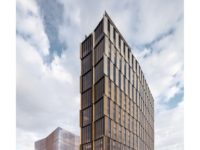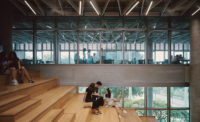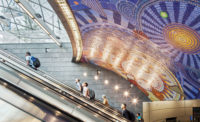The voices of college students have long been among the loudest clamoring for meaningful action to combat climate change. And universities have shown they share these values by commissioning buildings that aggressively pursue energy efficiency. Among the most recent projects are a group of standouts that smartly integrate extensive use of transparency, abundant daylighting, and natural ventilation. Amherst College’s Science Center, the Keller Center for Advanced Studies at the University of Chicago, and SDE4, a building for the School of Design & Environment at the National University of Singapore, all fuse resource conservation with strategies that create welcoming spaces and encourage collaboration, showing students what a sustainable future could look like.
It is hard to imagine that a science building could be one of the most popular hangouts on any campus, but making such a building was very much on the minds of Boston-based Payette Associates when they began designing the new Science Center to replace a 50-year-old building at Amherst, in western Massachusetts. In addition to desiring a building that would be state-of-the-art and highly energy efficient, the college hoped to reinforce the idea that deep explorations of science are an integral part of a liberal-arts education. “Amherst wants to celebrate science and demystify it,” says Payette principal Robert Schaeffner.
The 230,000-square-foot building is roughly E-shaped in plan, with three pavilions containing offices, study spaces, and classrooms projecting from the main volume, which houses a three-story commons and labs. To make science seem less enigmatic, the building has been designed so that the corridors and laboratories are enclosed in glass, visible from many parts of the campus through the commons’s three-story glazed curtain wall. Seventy-two percent of the floorplate has some direct view to the outside, and lab spaces enjoy views of the Pelham Hills to the east.
The 400-foot-long commons is the true star of the Science Center. Its west-facing orientation is not ideal, but solar radiation is controlled by low-E-coated triple-glazing and automated shades at the second and third levels. Motorized awning-style windows located over the four entries on the first floor are opened by the building automation system (BAS) to permit natural ventilation when temperature and humidity levels are right. Otherwise, supply air is provided by displacement diffusers located near the floor, while radiant heating and cooling run through the concrete slab and that of the balconies that overlook the commons.
The entire roof of the commons is covered by rows of roof monitors, which integrate multiple systems. Each monitor is supported by its own cantilevered steel beam, from which the curtain wall is also hung. Glazed, north-facing panels admit generous amounts of daylight, diffused by double-curved suspended ceiling panels, while south-facing photovoltaic (PV) panels are mounted on the outside of the monitors. Radiant cooling, sound attenuation, and lighting are also incorporated into the underside of the panels.
Laboratories are voracious consumers of energy because they contain lots of heat-generating equipment and exhaust large amounts of conditioned air through fume hoods. At Amherst, they are cooled year-round. But to conserve energy, air that has already been circulated through offices and corridors is drawn into the negatively pressurized labs and supplemented with additional ventilation when sensors detect that fumes are being created by experiments.
Placement of the offices and classrooms—the programmatic elements that the architects refer to as “low-energy”—in the projecting pavilions, with their own dedicated air-handling units, was another conservation strategy. Similarly to the commons, these spaces benefit from natural ventilation, which is admitted through operable facade panels. Although these are automated in classrooms, in the offices they are manually controlled. When sensors in the rooftop weather station send a signal to the BAS to indicate that the conditions are suitable, a green LED in the offices lights up to indicate that the panels can be opened (occupants also receive an e-mail notification).
Overall, the Amherst Science Center’s energy use intensity, or EUI (annual energy use divided by floor area), comes in at 91 kBtu per square foot per year, which is about 76 percent below a typical laboratory building, and 80 percent less than the building it replaces.
Students at the Harris School of Public Policy in Chicago, many of whom are focused on social and environmental issues, learn their craft at the Keller Center, a three-story building designed by Edward Durell Stone and opened in 1962. The 256-foot-wide structure resembles his American Embassy in New Delhi, sitting atop a 5-foot-high plinth, surrounded by a colonnade supporting deep roof overhangs. Two Chicago firms, Farr Associates and Woodhouse Tinucci Architects, have completely restored the exterior and opened up the interior in dramatic fashion.
The limestone- and precast-clad concrete-frame structure was originally the Kellogg Center for Continuing Education, a conference center and hotel, and was later made into a dorm. By the time the university began considering repurposing the building for the public-policy school, its mechanical systems were completely outdated and its previous use as housing so incompatible with its new program that the architects needed to entirely gut the interior. They sawed out concrete floor and roof slabs throughout the building to create open, light-filled spaces that reflect the Harris School’s attitude toward public-policy education. “The school uses a data-driven approach across multiple disciplines, treating policy-making like a science, to give it transparency,” says Farr associate principal Gabriel Wilcox. He maintains that leaving the cut concrete and rebar exposed is one version of transparency in architecture, while the new glazed walls that allow visibility into classrooms and study pods is another, more literal one. The aim is “to increase collaboration and engagement—to put policy on display so that you could see the activity and rigor as you step inside the door.”
Wilcox points to the Forum, the newly created four-story central atrium. The multilevel gathering space is finished in wood salvaged from Chicago Park District ash trees killed by invasive insects. It is topped by three rows of roof monitors and surrounded by glass walls that allow views into seminar and classrooms. The south-facing triple-layered fiberglass skylights admit daylight that bounces off curved white panels to soften and diffuse it. When the sun is high in the sky during the summer, exterior overhangs shade the fiberglass panels.
The new mechanical systems include radiant heating and cooling panels that are about 35 percent more efficient than conventional systems. The building’s performance was further enhanced by adding insulation to the exterior walls and the roof. Existing operable casement windows in offices along the perimeter of Keller were retained to save money and reduce embodied energy (the energy used in the production of a building). However, sliding windows were installed over them on the interior. When occupants desire natural ventilation, they open both the sliders and the casements. To prevent condensation, the office air-conditioning is automatically shut off.
With the addition of a rooftop PV system, which provides about 11 percent of the building’s energy, the LEED Platinum Keller Center maximizes all possible LEED energy points and achieves an EUI of 48 kBtu per square foot per year—a 46 percent reduction over the rating system’s baseline model. Wilcox is particularly proud that the project has also claimed the Living Building Challenge’s Materials Petal, which is especially relevant to Harris’s policy mission. It includes a prohibition against using materials containing ingredients on the certification system’s “Red List”—a group of chemicals commonly found in building products despite being harmful to humans and the environment.
The tropical climate of Singapore, the location of the School of Design & Environment building SDE4, is a striking contrast to the temperate zones of Chicago and Amherst. Maximizing energy conservation here was a project mandate. The administration wanted students to learn to design in a building that set the energy bar as high as possible—net zero—in order to challenge them to live up to that standard for the rest of their careers.
Serie + Multiply Architects of London, with Surbana Jurong of Singapore- and Germany-based climate engineers Transsolar Energietechnik, designed SDE4 to produce as much energy on its site as it consumes annually. The 91,000-square-foot, six-story building needed generous windows that would connect students to views of the lush surrounding landscape, and few interior walls. “Learning is far more social today,” said Chris Lee, principal of Serie + Multiply. “We needed to make learning visible. So the study, critique, and presentation spaces are designed in such a way that they can be seen from multiple angles within the building.”
Lee found inspiration in vernacular precedents such as Malay houses, which have large overhanging roofs. They are built on stilts with wide front elevations to capture breezes, but are otherwise shallow in depth. The 252-foot-wide south elevation of SDE4 looks toward the sea, but the building’s footprint is only about 88 feet deep. Its oversailing roof projects about 52 feet beyond the top-floor facade to provide shading while allowing extra area for PV panels.
Large parts of the second and third levels have no walls, left open to the elements for natural ventilation, and the east and west walls of the building are set back from perforated metal screens. These provide shade in the morning and late afternoon without completely blocking the view. The screens are designed so that they can be removed and substituted with experimental materials and assemblies for facade-research projects.
On the top two floors, studio spaces run almost the entire length of the building. Adjacent classroom, model-making, and workshop spaces are separated from the studios by glass walls. To control glare, exterior light can be blocked by user-operated roller shades, but “lamellas”—panels of horizontal metal fins—start about 6½ feet from the floor and extend to the ceiling. These direct the light onto the ceiling plane rather than screening it out entirely.
Transsolar used a number of modeling programs to refine the SDE4’s facade and envelope geometry and to design what Wolfgang Kessling, one of Transsolar’s directors, calls a hybrid cooling system. Full conventional air-conditioning is supplied only to those spaces where it is absolutely essential, such as computer labs. But most of the building is cooled to higher temperatures and humidity levels than is typical. Ceiling fans help compensate. “I’m taking care of the excess humidity, but I’m not overdrying the air. I’m taking care of excessive temperature, but I’m not overcooling the air,” says Kessling. “When I combine these two things with air movement, people are comfortable.” Occupants also have the option of opening sliding glass panels to let in fresh air, and then the hybrid cooling is automatically shut off.
Kessling says the strategy is performing well. Although the rooftop PVs are capable of producing only about 500 megawatt hours of electricity annually (roughly a quarter of the energy a building with this use in this climate would typically consume), SDE4 is operating at net positive. Now, 10 months after opening, it has produced 30 percent more energy than it has used, demonstrating the potential of design to help mitigate the climate crisis.
More buildings like SDE4, Amherst’s Science Center, and Keller—projects that provide healthy environments, superior energy performance, and the inspiration that comes from inhabiting beautiful architecture—would give students a measure of confidence that the future will be bright.
|
Continuing Education
 To earn one AIA learning unit (LU), including one hour of health, safety, and welfare (HSW) credit, read all eight articles in the "More than Academic" special section (listed below) and complete the online test. Upon passing the test, you will receive a certificate of completion, and your credit will be automatically reported to the AIA. Additional information regarding credit-reporting and continuing-education requirements can be found online at continuingeducation.bnpmedia.com. To earn one AIA learning unit (LU), including one hour of health, safety, and welfare (HSW) credit, read all eight articles in the "More than Academic" special section (listed below) and complete the online test. Upon passing the test, you will receive a certificate of completion, and your credit will be automatically reported to the AIA. Additional information regarding credit-reporting and continuing-education requirements can be found online at continuingeducation.bnpmedia.com.Special Section: More than Academic
Learning Objectives 1 Discuss strategies for balancing a desire for transparency—as an expression of an educational institution’s pedagogical mission—with the need for energy efficiency and occupant comfort. 2 Describe low-energy climate-control systems suitable for tropical climates. 3 Describe how universities are transforming former industrial buildings and disused academic buildings for new educational uses, and discuss methods for structural retrofit and seamless incorporation of new mechanical systems. 4 Discuss off-site fabrication as a strategy for building on constrained urban campuses, and outline the challenges to such an approach.
AIA/CES Course #K1911A
For CEU credit, read "Continuing Education: Colleges & Universities" and take the quiz at continuingeducation.bnpmedia.com, or use our Architectural Record Continuing Education app, available in the iTunes store. structure, finishes, and other original fabric when
a building is moved.
significant buildings.
|
















Post a comment to this article
Report Abusive Comment